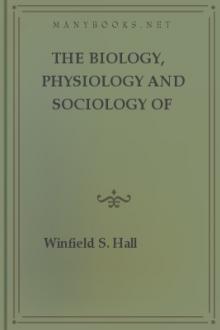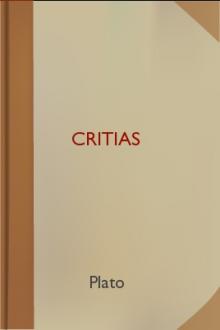Illusions, James Sully [speld decodable readers .TXT] 📗

- Author: James Sully
- Performer: -
Book online «Illusions, James Sully [speld decodable readers .TXT] 📗». Author James Sully
Hallucination, by which I mean the projection of a mental image outwards when there is no external agency answering to it, assumes one of two fairly distinct forms: it may present itself either as a semblance of an external impression with the minimum amount of interpretation, or as a counterfeit of a completely developed percept. Thus, a visual hallucination may assume the aspect of a sensation of light or colour which we vaguely refer to a certain region of the external world, or of a vision of some recognizable object. All of us frequently have incomplete visual and auditory hallucinations of the first order, whereas the complete hallucinations of the second order are comparatively rare. The first I shall call rudimentary, the second developed, hallucinations.
Rudimentary hallucinations may have either a peripheral or a central origin. They may first of all have their starting-point in those subjective sensations which, as we have seen, are connected with certain processes set up in the peripheral regions of the nervous system. Or, secondly, they may originate in a certain preternatural activity of the sensory centres, or "sensorium," in what has been called by German physiologists an automatic excitation of the central structures, which activity may probably diffuse itself downwards to the peripheral regions of the nerves. Baillarger would call hallucinations of the former class "psycho-sensorial," those of the latter class purely "psychical," hallucinations.[57]
It is often a matter of great difficulty to determine which part of the nervous system is originally concerned in these rudimentary hallucinations. It is probable that in normal life they are most frequently due to peripheral disturbance. And it seems reasonable to suppose that where the hallucination remains in this initial stage of a very incompletely interpreted visual or auditory impression, whether in normal or abnormal life, its real physiological source is the periphery. For the automatic excitation of the centres would pretty certainly issue in the semblance of some definite, familiar variety of sense-impression which, moreover, as a part of a complex state known as a percept, would instantly present itself as a completely formed quasi-percept. In truth, we may pretty safely argue that if it is the centre which is directly thrown into a state of activity, it will be thrown into the usual complex, that is to say, perceptional, mode of activity.
Let us now turn to hallucinations properly so called, that is to say, completely developed quasi-percepts. These commonly assume the form of visual or auditory hallucinations. Like the incomplete hallucinations, they may have their starting-point either in some disturbance in the peripheral regions of the nervous system or in the automatic activity of the central structures: or, to use the language of Baillarger, we may say that they are either "psycho-sensorial" or purely "psychical." A subjective visual sensation, arising from certain conditions in the retina and connected portions of the optic nerve, may by chance resemble a familiar impression, and so be at once interpreted as an effect of a particular external object. More frequently, however, the automatic activity of the centres must be regarded, either in part or altogether, as the physiological cause of the phenomenon. This is clearly the case when, on the subjective side, the hallucination answers to a preceding energetic activity of the imagination, as in the case of the visionary and the monomaniac. Sometimes, however, as we have seen, the hallucinatory percept answers to previous prolonged acts of perception, leaving a kind of reverberation in the structures concerned; and in this case it is obviously impossible to say whether the peripheral or central regions (if either) have most to do with the hallucination.[58]
The classifications of the causes of hallucination to be met with in the works of pathologists, bear out the distinction just drawn. Griesinger tells us (op. cit., pp. 94, 95) that the general causes of hallucination are: (1) Local disease of the organ of sense; (2) a state of deep exhaustion either of mind or of body; (3) morbid emotional states, such as fear; (4) outward calm and stillness between sleeping and waking; and (5) the action of certain poisons, as haschisch, opium, belladonna. The first cause points pretty distinctly to a peripheral origin, whereas the others appear to refer mainly, if not exclusively, to central derangements. Excessive fatigue appears to predispose the central structures to an abnormal kind of activity, and the same effect may be brought about by emotional agitation and by the action of poisons. The fourth case mentioned here, absence of external stimulation, would naturally raise the nervous structures to an exceptional pitch of excitability. Such a condition would, moreover, prove favourable to hallucination by blurring the distinction between mental image and actual impression.
Hallucinations of Normal Life.
In normal life, perfect hallucinations, in the strict sense as distinct from illusions, are comparatively rare. Fully developed persistent hallucinations, as those of Nicolai, the Berlin bookseller, and of Mrs. A——, the lady cited by Sir D. Brewster, in his Letters on Natural Magic, point to the presence of incipient nervous disorder. In healthy life, on the other hand, while everybody is familiar with subjective sensations such as flying spots, phosphenes, ringing in the ears, few fall into the error of seeing or hearing distinct recognizable objects in the absence of all external impressions. In the lives of eminent men we read of such phenomena as very occasional events. Malebranche, for example, is said to have heard the voice of God calling him. Descartes says that, after a long confinement, he was followed by an invisible person, calling him to pursue his search for truth. Dr. Johnson narrates that he once heard his absent mother calling him. Byron tells us that he was sometimes visited by spectres. Goethe records that he once saw an exact counterpart of himself coming towards him. Sir Walter Scott is said to have seen a phantom of the dead Byron. It is possible that all of us are liable to momentary hallucinations at times of exceptional nervous exhaustion, though they are too fugitive to excite our attention.
When not brought on by exhaustion or artificial means, the hallucinations of the sane have their origin in a preternatural power of imagination. It is well known that this power can be greatly improved by attention and cultivation. Goethe used to exercise himself in watching for ocular spectra, and could at will transform these subjective sensations into definite forms, such as flowers; and Johannes Müller found he had the same power.[59] Stories are told of portrait painters who could summon visual images of their sitters with a vividness equal to that of reality, and serving all the purposes of their art. Mr. Galton's interesting inquiries into the power of "visualizing" would appear to prove that many people can at will sport on the confines of the phantom world of hallucination. There is good reason to think that imaginative children tend to confuse mental images and percepts.[60]
The Hallucinations of Insanity.
The hallucinations of the insane are but a fuller manifestation of forces that we see at work in normal life. Their characteristic is that they simulate the form of distinctly present objects, the existence of which is not instantly contradicted by the actual surroundings of the moment.[61] The hallucinations have their origin partly in subjective sensations, which are probably connected with peripheral disturbances, partly and principally in central derangements.[62] These include profound emotional changes, which affect the ruling mental tone, and exert a powerful influence on the course of the mental images. The hallucinations of insanity are due to a projection of mental images which have, owing to certain circumstances, gained a preternatural persistence and vividness. Sometimes it is the images that have been dwelt on with passionate longing before the disease, sometimes those which have grown most habitual through the mode of daily occupation,[63] and sometimes those connected with some incident at or near the time of the commencement of the disease.
In mental disease, auditory hallucinations play a part no less conspicuous than visual.[64] Patients frequently complain of having their thoughts spoken to them, and it is not uncommon for them to imagine that they are addressed by a number of voices at the same time.[65]
These auditory hallucinations offer a good opportunity for studying the gradual growth of centrally originating hallucinations. In the early stages of the disease, the patient partly distinguishes his representative from his preservative sounds. Thus, he talks of sermons being composed to him in his head. He calls these "internal voices," or "voices of the soul." It is only when the disease gains ground and the central irritability increases that these audible thoughts become distinctly projected as external sounds into more or less definite regions of the environment. And it is exceedingly curious to notice the different directions which patients give to these sounds, referring them now to a quarter above the head, now to a region below the floor, and so on.[66]
Range of Sense-Illusions.
And now let us glance back to see the path we have traversed. We set out with an account of perfectly normal perception, and found, even here, in the projection of our sensations of colour, sound, etc., into the environment or to the extremities of the organism, something which, from the point of view of physical science, easily wears the appearance of an ingredient of illusion.
Waiving this, however, and taking the word illusion as commonly understood, we find that it begins when the element of imagination no longer answers to a present reality or external fact in any sense of this expression. In its lowest stages illusion closely counterfeits correct perception in the balance of the direct factor, sensation, and the indirect factor, mental reproduction or imagination. The degree of illusion increases in proportion as the imaginative element gains in force relatively to the present impression; till, in the wild illusions of the insane, the amount of actual impression becomes evanescent. When this point is reached, the act of imagination shows itself as a purely creative process, or an hallucination.
While we may thus trace the progress of illusion towards hallucination by means of the gradual increase in force and extent of the imaginative, or indirect, as opposed to the sensuous, or direct, element in perception, we have found a second starting-point for this movement in the mechanism of sensation, involving, as it does, the occasional production of "subjective sensations." Such sensations constitute a border-land between the regions of illusion in the narrow sense, and hallucination. In their simplest and least developed form they may be regarded, at least in the case of hearing and sight, as partly hallucinatory; and they serve as a natural basis for the construction of complete hallucinations, or hallucinatory percepts.
In these different ways, then, the slight, scarcely noticeable illusions of normal life lead up to the most startling hallucinations of abnormal life. From the two poles of the higher centres of attention and imagination on the one side, and the lower regions of nervous action involved in sensation on the other side, issue forces which may, under certain circumstances, develop into full hallucinatory percepts. Thus closely is healthy attached to morbid mental life. There seems to be no sudden break between our most sober every-day recognitions of familiar objects and the wildest hallucinations of the demented. As





Comments (0)